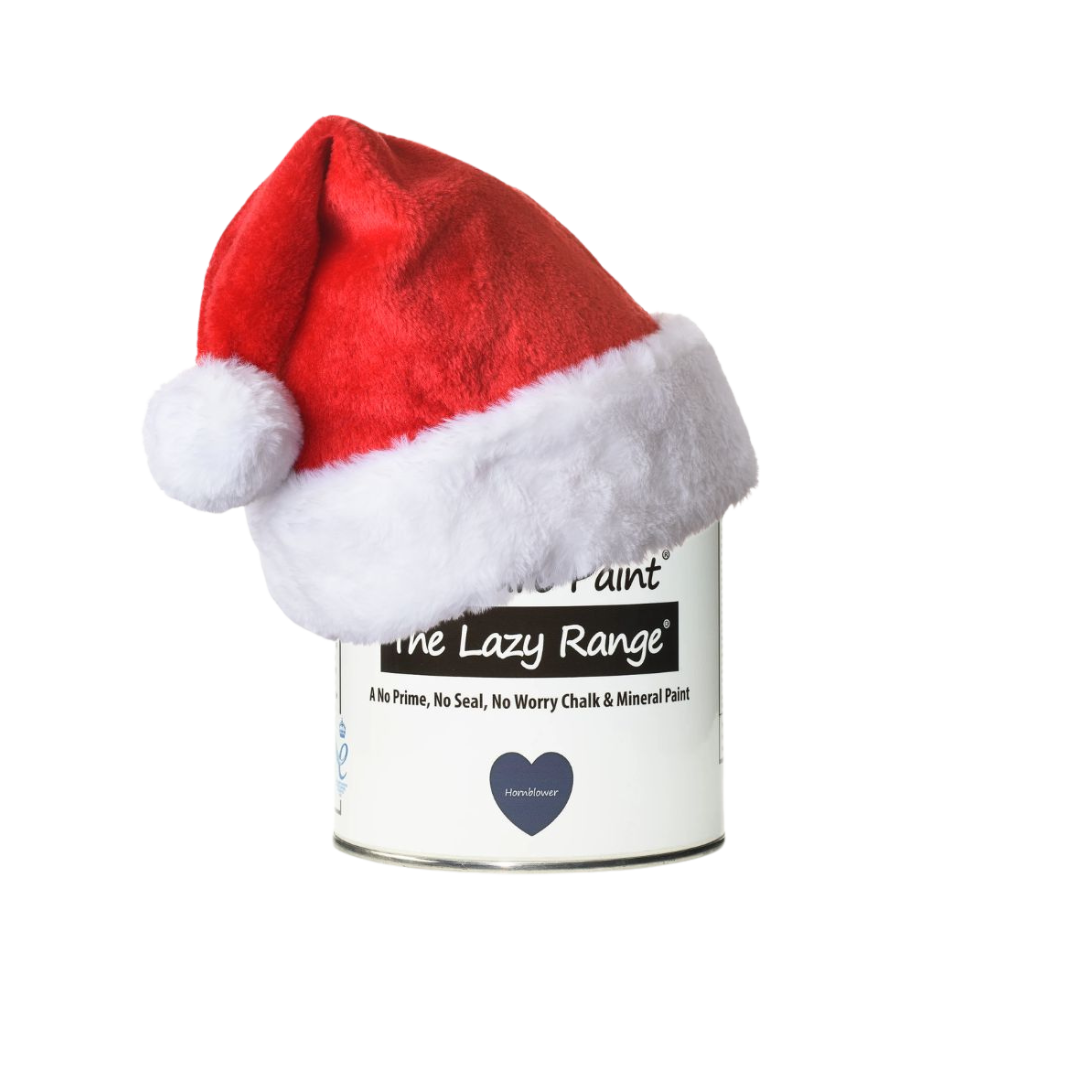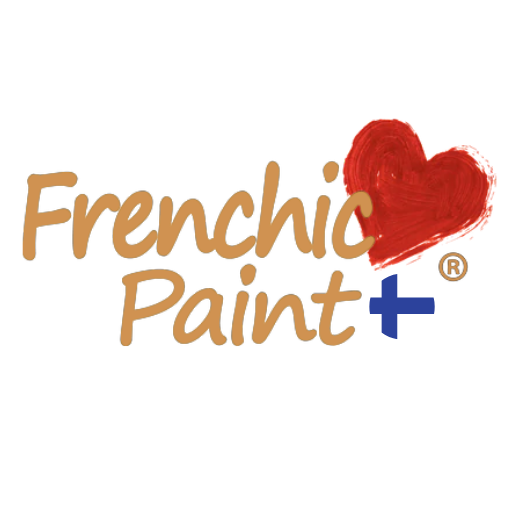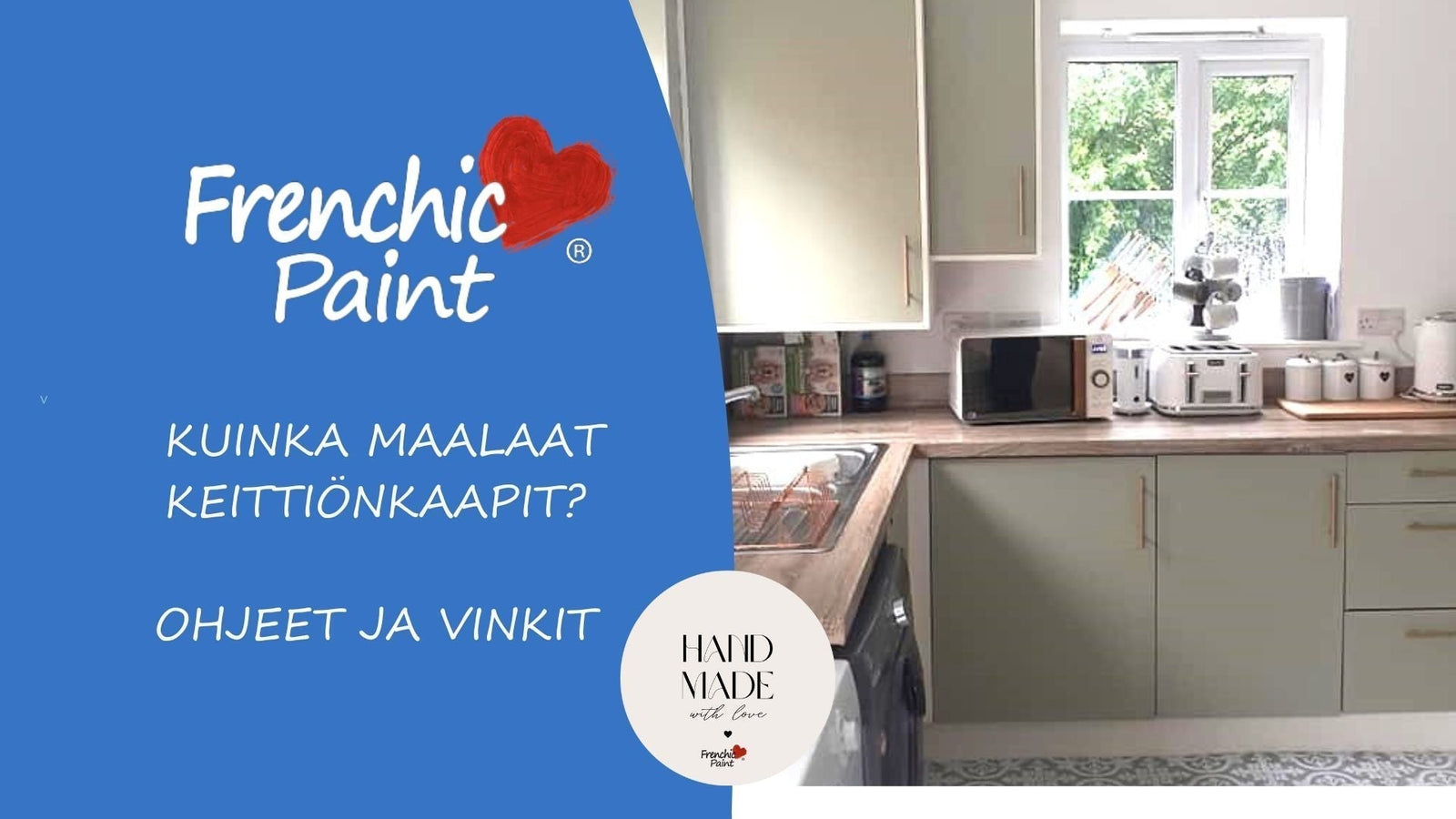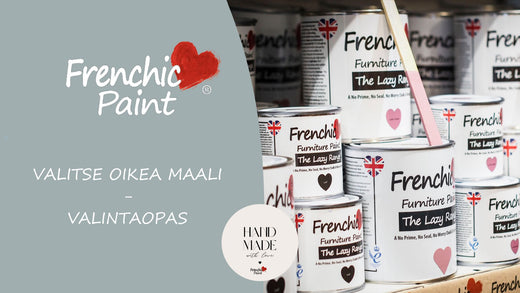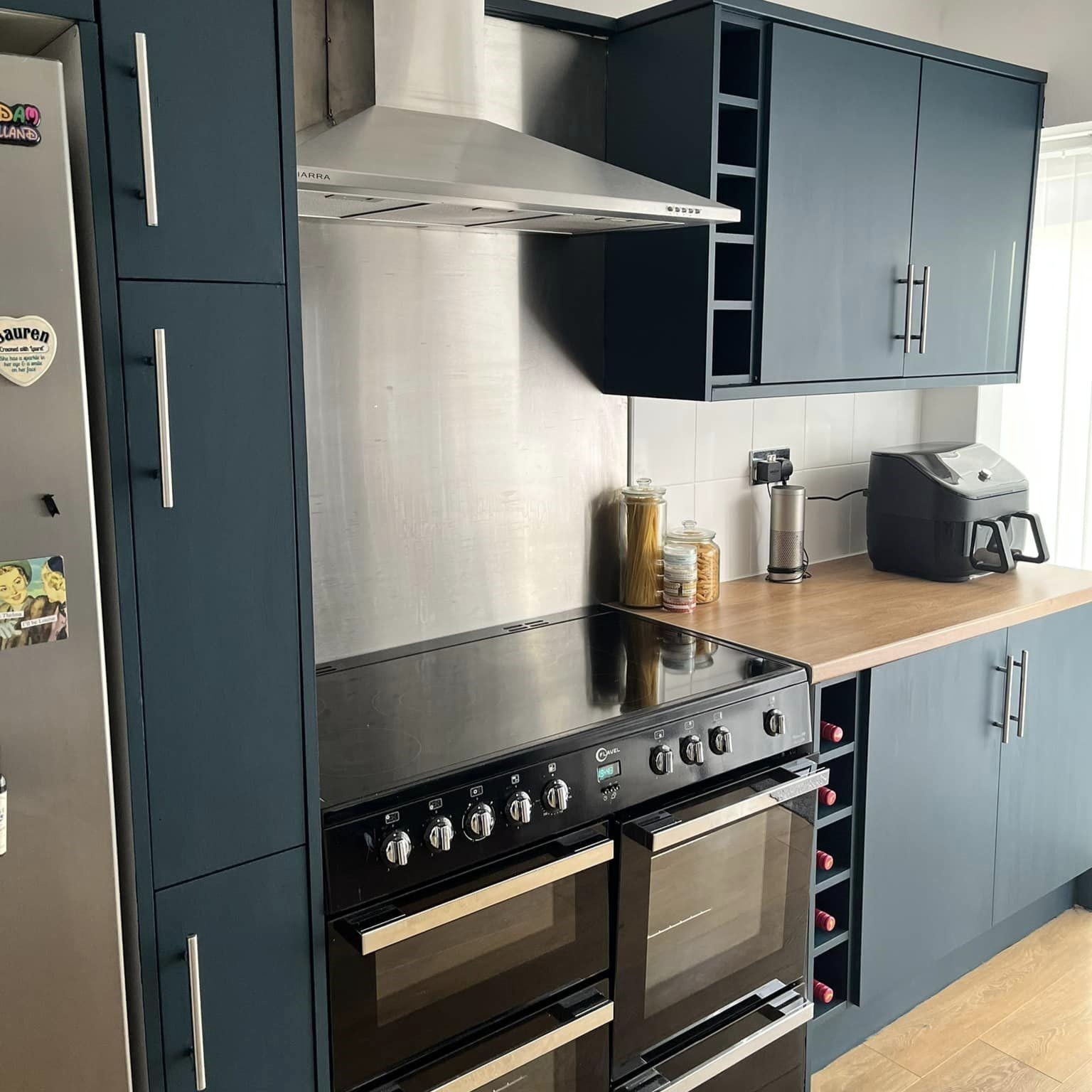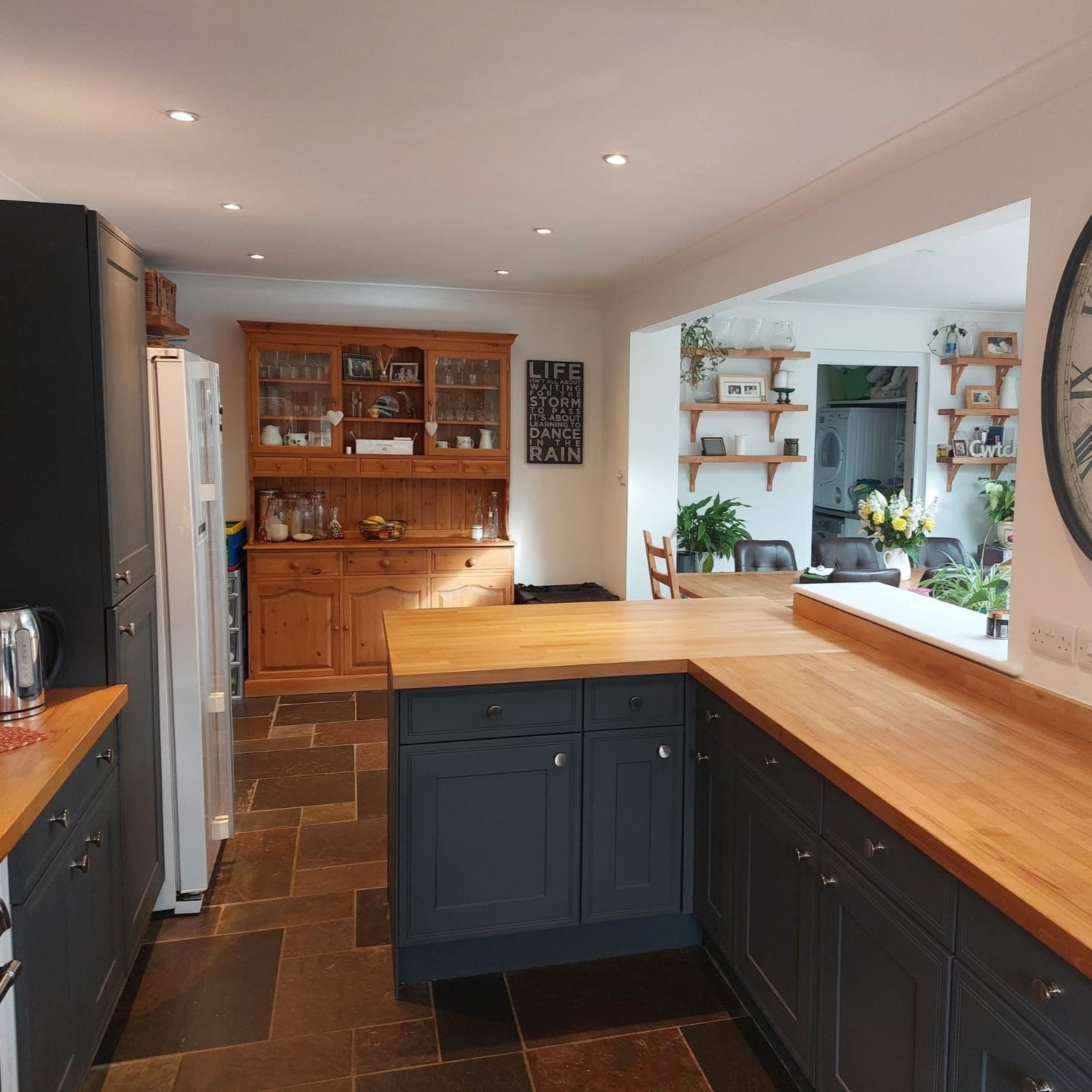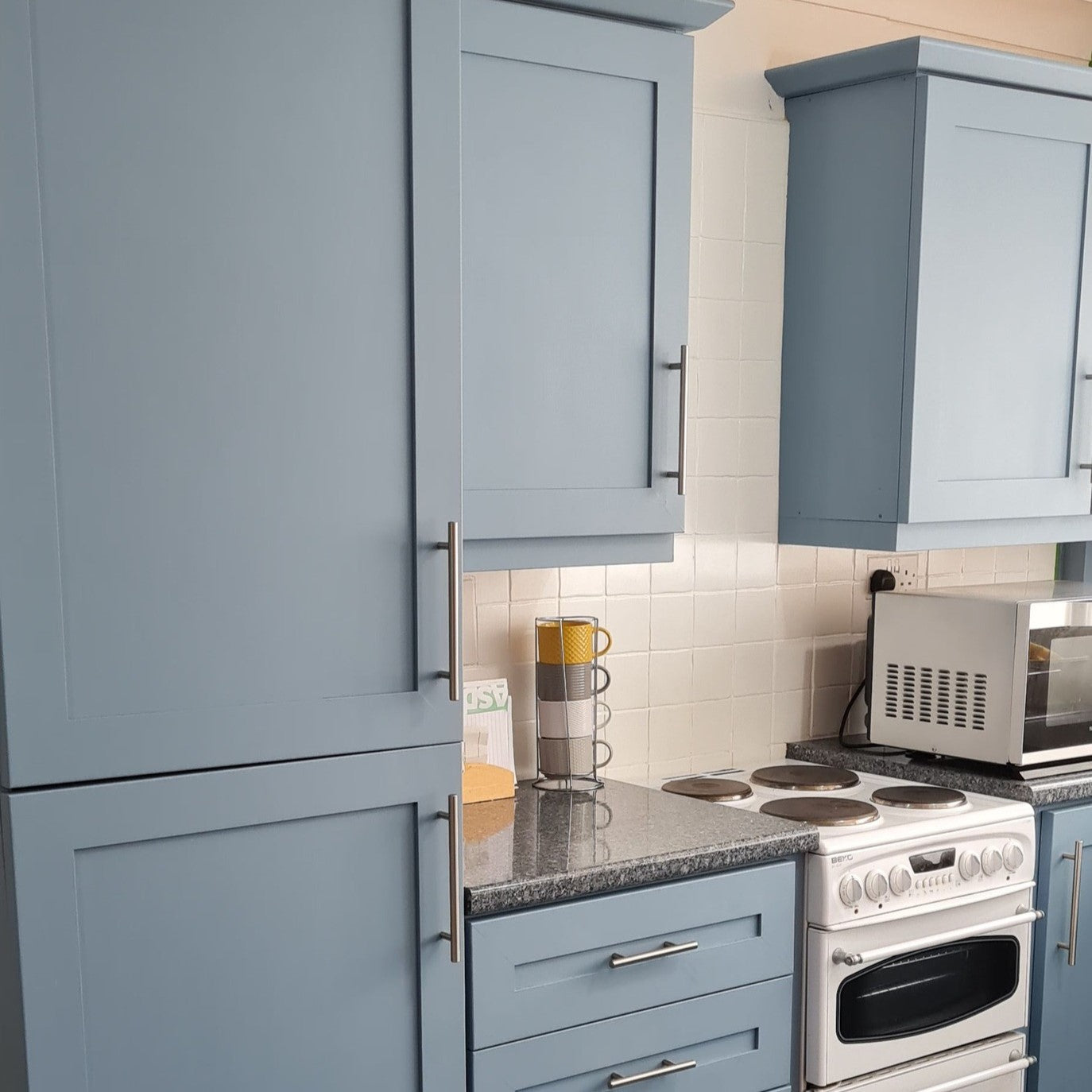FAQ - Vanliga frågor och svar 2
Hur skiljer sig Frenchic Paint från andra färgserier? Är Frenchic Paint verkligen hållbar?
Den prisbelönta Frenchic Paint® har satt nya standarder för möbelmålning och gjort det enklare och roligare – om du tidigare tyckt att kalkfärg inte är hållbar eller praktisk, är det hög tid att prova Frenchic!
Läs här de vanligaste frågorna med svar, så får du värdefull information om vår serie.

Frenchic Paints nya egenskaper i korthet:
- Snabb torktid
- Nästan doftfri
- Jämnar ut sig till en vacker, slät yta
- Särskilt dryg
- Verkligen täckande
- Nästan droppfri
- Innehåller grundfärg
- Hållbar och tvättbar yta utan lack eller vax
- Vacker matt yta
- Underbara, dämpade nyanser
Vackert självutjämnande Frenchic Paint ger dig ett försprång och du uppnår en slät yta lättare än med andra målarserier.
Vi vill erbjuda våra kunder massor av råd, knep och tips för att göra arbetet, eftersom varje målningsjobb och varje målares "handstil" alltid är unik.
Frenchic-seriens produkter och tillbehör är prisbelönta, högkvalitativa, hållbara och testade.
De har genomgått flera tester för säkerhet, giftfrihet och hållbarhet och vunnit många priser och tester, så du kan vara säker på Frenchic Paint-kvaliteten när du använder våra produkter enligt anvisningarna.


Vi får många frågor från våra kunder och här är några av de vanligaste med svar:

F: Jag har hundra och ett projekt på gång, var kan jag enkelt kontrollera vilken Frenchic målarserie som passar för mina olika projekt och ytor?
S: Generellt: för inomhusprojekt passar vilken Frenchic-serie som helst och för utemöbler endast Al Fresco. Alla serier passar för trä, mdf och metall.
Mer detaljerat via denna länk.


F: Varför skulle jag välja Frenchic Paint?
S: Du väljer enkelhet, snabbhet och ett vackert slutresultat. Du sparar både arbetstid och material när du väljer Frenchic-seriens "all in one"-färg.
Du undviker spill eftersom Frenchic Paint passar för många ytor. Den nya recepturen gör Frenchic-serien till en föregångare på målningsmarknaden.
Frenchic Paint har många helt nya egenskaper, och serien har också belönats: till exempel utjämningen av målarytan och den lättapplicerade konsistensen.
Till exempel Al Fresco sarjan maalit passar för målning av inomhus- och utemöbler.
Trä, metall, mdf, plast och olika typer av skivmaterial. Målaren har redan grundfärg och andra skyddsmedel, så lack eller vax behövs inte för efterbehandling.
Torktiderna är betydligt kortare än vanligt: torktiden för ett lager i Al Fresco-serien är 2h.
Målarna har dessutom en ny sorts självutjämnande egenskap, vilket gör att målarytan blir vackert slät.
Färgernas konsistens är något tjockare och droppfri än vanligt, målningen är enkel och färgen glider lätt.
Färgerna är 100 % vattenbaserade, säkra att använda och nästan helt doftfria, certifierade. Resultatet är en vacker och hållbar matt yta. Frenchic-seriens nyanser är vackra inredningsfärger som passar många inredningsstilar. Pudriga matta nyanser passar också för kulturbyggnader och kombineras vackert med papperstapeter.

Färger utvecklas också och nya produkter är ännu säkrare och giftfria. Varför inte välja det bästa!

F: Kan jag börja måla direkt när jag öppnar färgburken?
S: Börja inte måla med oomrörd färg. Frenchic-färger innehåller tungt pigment som snabbt sjunker till botten av burken och oomrörd färg kan orsaka oönskade nyansvariationer.
Oomrörd färg påverkar också täckförmågan och ythållbarheten negativt om de nyttiga skyddsämnena i färgen inte blandas jämnt i färgen. Rör därför alltid om din Frenchic-färg noggrant.
Du märker pigmentets vikt i botten av burken. Vi rekommenderar att du rör om färgen noggrant, länge och ända ner i botten både före målning och under målningsprojektet.
Välj en bred spackel eller en bred träblandare för manuell omrörning, eller en elektrisk visp.

F: Tål Tuff Top Coat utomhusmöbler eller ytan på ytterdörren?
S: Ja, båda Tuff Top Coat är väderbeständiga.

F: Vad betyder 'juvelfärg'?
S: Till exempel Plum Pudding, Victory Lane samt Constance Moss, After Midnight och Steel Teal -nyanser är gjorda för en genomskinlig grund för att du ska få en fantastisk djup juvelfärg, så de kräver ett extra lager eller två.
Tips med dessa nyanser, särskilt om du målar en vit grund - är att först måla en mörk grund, så ett lager City Slicker/Smudgea och sedan cirka 3 lager färg. Så får du enkelt en fantastisk juvelton.


F: Kan man använda gammal färg?
S: Om färgens konsistens vid omrörning känns, ser ut och luktar normalt, gör ett testmålning och om allt är normalt kan du använda färgen.
Om färgen luktar illa och inte blandas jämnt rekommenderar vi inte att använda den. Frusen eller frostskadad färg rekommenderas inte att användas.
Färgen förstörs lätt av smutsigt vatten, pollen eller annat skräp eller byggdamm vid målning utomhus.
Färgen förstörs av bakterier som också kan komma in i färgen via smutsiga penslar.
Rätt förvarad håller ren färg minst ett par år även efter att den öppnats.


F: Hur får jag en möbel som luktar illa att bli luktfri?
S: Behandla den tvättade och torra ytan helt runt med Finish Coat enligt anvisningarna. Det är allt!


F: Räcker ett lager färg?
S: Nej. Frenchic Paint ska alltid målas minst två gånger.
Även om det första lagret täcker, jämnar det andra lagret ut nyansen vackert, täcker små fel och påverkar ytan positivt när det gäller hållbarhet. Då återges också nyansen som tillverkaren avsett.
Ibland kan du behöva flera lager om färgskillnaden mellan ytan som ska målas och den valda nyansen är stor. Testa den valda nyansen på en diskret plats innan du gör ett större jobb.
Om det står två lager i färgburkens anvisningar, applicera två lager.
Om täckningsanvisningarna säger att burken räcker till sex kvadratmeter, och efter att ha målat en yta av den storleken finns det mycket färg kvar, är färglagren för tunna.
Läs här för att få veta hur många lager färg som behövs.
För att uppnå ett hållbart resultat måste du applicera mer färg.
Frenchic Paint behöver inte spädas och den självutjämnande egenskapen i färgen gynnas av riklig penselrörelse.


F: När kan jag måla ett andra lager färg?
V: Måla ett andra lager först när det föregående färglagret har torkat enligt anvisningarna. Torktiden per lager hittar du på färgburkens sida och produkternas informationssida.
-
Lazy Range: torktiden per lager är 1 timme.
-
Al Fresco: torktiden per lager är 2 timmar.
-
Trim Paint: torktiden per lager är 4 timmar.
-
Väggfärg: torktiden per lager är 2 timmar.

K: Jag orkar inte tvätta möbeln, kan jag börja måla direkt?
V: Du målar väl inte på en smutsig yta.
Frenchic Paint är vattenbaserade och avvisar smuts och fett. Även från en möbel och yta som ser ren ut kan det komma ut smutsigt vatten vid tvätt.
I värsta fall går ditt noggranna målningsarbete förlorat om du målar på en smutsig yta: Färgen kan inte fästa på underlaget eftersom smuts och fett finns emellan, vilket kan göra att färgen börjar flagna.


K: Jag orkade inte slipa, påverkar det på något sätt?
V: Ytruggning hjälper färgen att fästa bättre på ytan och påverkar hållbarheten mycket.
Lätt ruggningsbehandling för hand, t.ex. med slip-svamp, är ett snabbt och enkelt arbetsmoment som alltid är värt det.
Tänk i förväg på vad du ska måla - om möbeln eller ytan utsätts för hårt slitage är noggrann ruggningsbehandling verkligen på sin plats.
Speciellt om du målar en hal, blank och slät yta, rugga alltid upp ytan innan målning. Läs här målningstips för laminatmöbler.
En tumregel kan vara: ju hårdare slitage ytan utsätts för, desto noggrannare bör slipning och andra förberedelser göras.
Frenchic Paint har utmärkt vidhäftning, men alla färger gynnas av slipning eller åtminstone ytruggning. Slipningen görs på en ren yta.


K: Jag slipade först och tvättade sedan, var det fel?
V: På sätt och vis, eftersom du genom att slipa en smutsig yta kan slipa in all smuts djupt in i träets fibrer.
Och samtidigt täpps ditt sandpapper eller slip-svamp snabbt igen av smuts och fett och blir oanvändbart.
Slipa alltid bara rena ytor.


F: Vilken Frenchic vit motsvarar Tikkurilas vita? Jag tänker måla lister och innerdörrar.
F: Frenchic Paint-seriens nyanser är helt unika och har ingen fullständig motsvarighet i andra serier. Yorkshire Rose ligger nära den inhemska listvitfärgen.

F: Kan jag blanda Tuff Top Coat i färgen – blir ytan då mer hållbar?
F: Vi rekommenderar inte det.
Det kan påverka färgens hållbarhet negativt. Vi rekommenderar att du applicerar Tuff Top Coat ovanpå den torra färgen enligt instruktionerna, vilket ger extra skydd mot slitage på ytor med hård användning, som till exempel köksbänkskivor.


F: Jag målade trappans räcken för ungefär fyra år sedan och nu är färgen sliten på vissa ställen. Varför händer detta?
F: Räckena och ledstängerna utsätts för fett från händer och annan smuts.
Även förberedelser och rengöring som görs före målning har stor påverkan på färgens hållbarhet – all smuts och fett måste tas bort från ytan innan målning. När färgen slits på utsatta ställen, gör en underhållsmålning vid behov.


F: Hur mycket färg behöver jag?
F: Förbrukningen beror på många faktorer.
Generellt kan man säga att med en liten 250ml burk färg kan du måla till exempel två nattduksbord eller två till tre stolar.
En 750ml burk räcker gott till exempelvis en stor garderob med tre dörrar för två lager färg.
Färgförbrukningen för målning av vanliga köksskåp är ofta 2x750ml.
Färgförbrukningen ökar från det vanliga om ytan som ska målas är porös, ojämn eller om grundfärgens skillnad är stor jämfört med den valda nyansen.
Du behöver mer färg än vanligt om du bestämmer dig för att måla möbelns eller skåpens baksida och insidor.
Färgförbrukningen påverkas också av det valda målningsverktyget, tekniken och varje målares egen målningsstil.
En ojämn yta, som präglad vinyltapet, glasfibertapet eller panel, kräver alltid mer färg än normalt. Porösa ytor, som rent trä eller MDF, absorberar mycket färg. Rekommendationen är därför att försegla porösa ytor före målning med Finishing Coat-ytbehandlingen.

Antalet lager är normalt två, men det kan variera om färgen är omsorgslöst blandad, torktiden mellan lagren inte följs eller om grundfärgen skiljer sig mycket från den valda nyansen.
Besök närmaste återförsäljare så får du råd om förbrukning. Kolla även FB-gruppen för att se vad andra säger om förbrukning i liknande projekt som du planerar.
På sidan av varje Frenchic Paint-färgburk står tillverkarens angivna täckförmåga och du hittar den i produktinformationen här i webbutiken, under varje nyans.
Frenchic Paint-färgers täckförmåga på en jämn och icke-absorberande yta:
-
Lazy Range: 750ml: 12,5m2och 250ml: 3,5m2
-
Al Fresco: 750ml: 12,5m2och 250ml: 3,5m2
-
Trim Paint:500ml: 7m2
-
Väggfärg: 2,5L: 35m2

F: Var kan jag få en liten mängd färg för test?
F: 250ml små burkar är testburkar från Frenchic Paint-serien.
Om du beställer idag har du ditt paket inom några vardagar!


F: Hjälp! Min favoritfärg Al Frescos Blackjack var slut igen! När kommer den in igen?
F: Om du målar inomhusytor, inredningsdetaljer eller köksskåp kan du välja samma underbara mattsvarta från dessa serier också:
- Från Lazy Range-serien (Loof),
- Trim Paint-serien (500ml, satin)
- Från väggmålningsserien (2,5l ultramatta).
Alla Frenchic Paint-serier är stänksäkra, avtorkningsbara och hållbara i vardagen.
Endast färger från Al Fresco-serien är lämpliga för utomhusmöbler.
På grund av stor efterfrågan är vissa Frenchic-produkter slut i lager. Om produkten du söker är slut fylls lagret på automatiskt så småningom. Vi svarar inte på enskilda förfrågningar om tillgänglighet eftersom leveranstider kan variera mycket. Du kan också fråga din närmaste återförsäljare om produktens tillgänglighet.


F: Vi har fest nästa helg, hinner jag måla hela köket den här veckan? Jag har inte provat era färger tidigare.
S: Vi rekommenderar att du först provar färger och verktyg innan ett större projekt.
Så lär du känna färgåtgången, täckförmågan och torktiderna.
Du märker vilket resultat dina valda verktyg ger och vilket slutresultat du själv är nöjd med – och du märker hur snabbt eller långsamt ditt projekt går.
Tänk också på färgens torktider. Du kan börja använda det nymålade köket försiktigt efter 48 timmar. Var försiktig med målade ytor i några veckor tills färgen nått sin slutliga hårdhet.


F: Kan jag måla barnstolen?
S: Ja! Frenchic Paint har fått europeisk "Toy Safe"-certifiering, så det är säkert att måla även barnmöbler med våra färger.
I målningsbeslutet bör man dock vara realistisk: barnstolen utsätts för mycket slitage och rengörs ofta med både rengöringsmedel och redskap när torkad gröt, mat och dryck skrapas bort från stolens fogar.
Hård användning på möbeln osv. betyder inte att den inte kan målas.
Alla färgytor påverkas av starka rengöringsmedel, särskilt desinfektionsmedel och användning av repande rengöringsredskap. Var beredd på normal punktmålning.


F: Jag vill måla mina trädgårdsmöbler i trä när snön smält och jag fått dem rena från snö och is. Vilken färg rekommenderar ni?
S: Al Fresco-seriens färger är avsedda för utomhusmöbler.
Trämöbler måste vara torra, även inifrån träet – och rena innan målning. Vinterns fukt kan finnas kvar länge inuti trämöbeln, så möbler som stått ute kan inte målas direkt efter snön smält.
Ta möblerna i solen och skydda dem från regn för att torka innan rengöring och målning. Läs Ute målningsinstruktioner innan du börjar.
Förvara målade möbler skyddade från väder och vind under vintern.


F: Jag letar efter en perfekt grå väggfärg som inte drar åt blått eller grönt. Finns det en sådan i Frenchic Paint-serien?
F: Finns: Stone in Love.
Samma nyans finns också i Trim Paint-serien, som passar för målning av möbler, köksskåp, dörrar och lister.


F: När kan jag måla efter regn?
F: Vänta minst ett dygn.
Efter regn eller tvätt av möbeln måste du vänta tills möbeln är helt torr (vått trä känns kallt mot handen). Trämöbeln måste också vara torr inifrån innan målning.
En tumregel kan vara: tvätta och måla möbeln på olika dagar.

F: Kan man måla över tapet med Frenchic Paint?
F: Ja.
Välj väggfärg för målning av väggen och kontrollera innan du börjar att tapeten sitter fast på väggen. Du kan måla över tapeten.


F: Å nej - min burk är bucklig! Varför skickade ni en bucklig burk till mig? Kan jag använda färgen?
F: Den tunna metallhöljet på färgburkar går ganska lätt att buckla.
Under transporten kan den metalliska färg- eller vaxburken inuti paketet ha fått bucklor, även om kartongen inte visar några tecken på skada utvändigt - kartong är ju ett flexibelt material, till skillnad från tunn metall.
Eftersom paketen ska transporteras effektivt och, på kundernas önskan, så snabbt som möjligt, utsätts paketen för hårda påfrestningar under transportprocessen.
Som tur är påverkar bucklor eller intryckningar på burkens sida inte färgens kvalitet alls. Du kan alltså använda färgen utan oro.
Vi skickar inte skadade produkter eller buckliga burkar till våra kunder.


F: Kan jag måla i ett kallt garage under vintern?
F: Målning bör göras under rätt förhållanden. +10 grader är minimum både för målningsarbetet och torkningsprocessen - dygnet runt.
Om du målar i för varm temperatur eller i direkt solljus torkar färgen för snabbt och hinner inte jämna ut sig - resultatet blir garanterat vackra penseldrag.
Om du målar i för kallt väder torkar inte färgen inom den tid som tillverkaren avsett, och du kan inte arbeta vidare med nästa lager eller steg. Här kan du läsa mer om hur vädret påverkar ditt målningsprojekt.
Läs utomhusmålningens instruktioner innan du börjar. Förvara målade möbler skyddade från väder under vintern.


F: Jag skulle vilja måla en barns loftsäng. Vilken färg rekommenderar ni?
F: Du kan välja nyans för inredningsmöbler från vilken serie som helst: Trim Paint, Lazy Range och Al Fresco.
Alla Frenchic Paint-seriens färger är säkra och testade för målning av barnmöbler och till och med leksaker. Ta hänsyn till färgens torktider i ditt målningsprojekt.


F: Jag skulle vilja måla ett element, en kakelugn eller en öppen spis med Frenchic Paint-seriens färger - går det?
F: Det går bra. Planera dock målningen utanför uppvärmningssäsongen, varma eller heta ytor får inte målas.
Målning av metall fungerar, liksom ytor som värms måttligt, till exempel vattenburna element och ytor som inte värms över 80 grader.
Du kan enkelt kontrollera yttemperaturen på din kakelugn med en termometer. Både element och ugnar måste vara kalla vid målning och måttlig uppvärmning kan påbörjas först två dygn efter att målningsarbetet är klart.
Fet sot måste rengöras noggrant från ytan som ska målas innan målning. Frenchic Paint-seriens färger innehåller inga rostskyddsmedel.
Frenchic Paint-seriens färger har inte officiellt testats för värmetålighet. Många av våra kunder har målat kakelugnar med gott resultat.
Generellt tål vattenbaserad färg, som Frenchic Paints, värme upp till 70-80 grader. Du kan enkelt mäta temperaturen på din yta med en termometer innan målning.


F: Jag skulle vilja måla om de gamla köksskåpsdörrarna - vilken serie passar för det?
F: Du kan välja färg för målning av köksskåp från vilken Frenchic Paint-serie som helst: Väggfärg, Trim Paint, Lazy Range och Al Fresco-serien.
Ta hänsyn till färgens torktider i ditt målningsprojekt och läs tips om målning av köksinredning innan du börjar från Frenchic Bloggar.


F: Vilken färgserie behöver beläggning, vax eller lack?
F: Endast för Original Artisan-seriens färger. (slutsåld, säljs inte längre i Finland)

F: När ska man använda Finish-beläggningar?
F: Om du vill ha extra skydd särskilt för köksbänkskivor eller andra ytor som utsätts för hård belastning, eller om du vill ha en blank yta istället för matt färg.
Vi rekommenderar alltid den matta Tuff Top Coat-beläggningen för målare av bordsytor och bänkskivor.
Du kan också använda den matta Tuff Top Coat för att skydda målade ytor på köksskåp.
Om du vill ha en blank yta, lägg till några lager Finishing Coat ovanpå den torra färgytan.
Frenchic-seriens beläggningar är lätta att stryka ut och torkar snabbt. Läs arbetsinstruktionerna i produktinformationen.


F: Kan jag måla över Frenchic-färger med en vanlig annan färg? Eller med en annan färg från Frenchic-serien?
F: Ja och ja - om du inte har använt självapplicerande möbelvax.
Gör samma förberedelser som vanligt: rengör ytan och rugga upp innan målning. Om du har vaxat ytan, se instruktionerna här.

F: Jag planerar färgskalan för mitt nya hem. Var kan jag se Frenchic-nyanser live?
F: Vi rekommenderar att beställa en färgcirkel för planering och att besöka närmaste Frenchic-återförsäljare. Se kontaktuppgifter på kartan.
Du kan också beställa små burkar för att prova nyanser i webbutiken.


F: Var kan jag få en rabattkod eller annan rabatt till webbutiken?
F: Det är sällan rabatter i vår webbutik, men våra e-postprenumeranter får förmåner under året och hör först om erbjudanden eller andra fördelar.
Observera att du endast kan använda en förmån åt gången och att rabatter inte kan kombineras. Utgående produkter och -50% rabatter hittar du här.
De sista exemplaren och utgående produkter varierar, så håll ett öga på denna sida.

F: Kan era färger användas för konst och målning av tavlor?
F: Självklart!
Och många använder dem – matt yta ser fantastisk ut i konstprojekt. Konstnärer har också upptäckt våra giftfria metallpigmentnyanser, Frensheen-serien.

F: Jag sysslar med restaurering av antika möbler och bygger ibland egna möbler. Är Frenchic vax lämpliga för antika möbler eller för ytbehandling av träytor?
F: Absolut! Mjuka Frenchic-vax är naturliga vaxer och innehåller bivax, så med dem kan du vårda och skydda dina antika möbler.
Med Frenchic vax får du vackra, tunna lager utan ansträngning. Du kan välja ett färdigtonat vax eller ett klart vax för att vackert fördjupa möbelns nyans.
Även Frenshimmers metallnyanserpassar för restaurering av gamla möbler, dekorationsmålning och målning av beslag.

F: Var kan jag läsa fler frågor och svar?
F: Här.

F: Var hittar jag bra målningsinstruktioner?
F: Målningsinstruktioner hittar du här och fler instruktioner finns i Frenchic Bloggar.
Läs också målningsinstruktionerna på burkens etikett innan du börjar.
Arbetsinstruktioner för varje produkt finns vid varje produkt, öppna bara en ny flik.

F: Hur kan jag vara säker på nyansen - jag litar inte på bilderna i webbutiken.
F: Du kan vara helt säker bara genom att testa färgen på den plats där den är tänkt att användas. Små 250 ml burkar är avsedda för nyanstestning.
Vi gör allt vi kan för att säkerställa att nyanserna i webbutiken motsvarar så nära som möjligt de verkliga nyanserna, men nyanserna kan variera på olika enheter (din telefon, din surfplatta, din stationära dator) beroende på flera faktorer, såsom inställningarna på din enhets skärm.
Detta innebär att vi inte kan garantera att färgens nyans exakt motsvarar det du ser på din skärm.
Därför är det värt att bekanta sig med våra kunders bilder till exempel i Facebook-gruppen, så ser du flera bilder av samma nyans. Här kan du se alla våra andra sociala kanaler.
I gruppen kan du enkelt göra sökningar till exempel på nyansens namn.

F: Hur kan jag vara säker på nyansen - jag vill inte göra ett testmåleri.
F: Du kan beställa färgkartan eller Peel & Stick-nyansprover hem och på så sätt säkerställa nyanserna.


F: Varför ser färgen jag valt helt annorlunda ut i mitt hem än hos min vän?
F: Du har olika ljus och skuggor i ditt eget hem.
Ljusare rum återger nyanser annorlunda än skuggiga. Rum som vetter mot norr har andra nyanser än de som vetter mot söder.
Tid på dygnet och olika årstider påverkar färgåtergivningen. Granska färgen i olika belysningar, just i det rum där du tänkt använda nyansen.
Granska färgens nyans först när den är torr, efter två lager.
När du testar nyanser, observera också att färgen återges olika på vertikala ytor jämfört med horisontella ytor.
Den perfekta vita eller beige kan vara helt olika nyanser i vardagsrummet jämfört med sovrummet - eftersom ljuset kommer från olika väderstreck.
Du har säkert också andra stora färgytor i ditt hem som kan reflektera den valda nyansen: tak, golv, matta, överkast, gardiner...
100% säkerhet om färgen får du genom att prova den på den yta där färgen är tänkt att användas. Bedöm nyansen först när den är torr, efter två lager.
Valet av nyans bör alltid göras i det rum och på den yta där den är tänkt att användas. Observera att kvällssolen och dagens ljus påverkar färger på olika sätt. På vintern är ljuset av en annan färg än på sommaren. Även de lampor du använder i rummet påverkar färgåtergivningen.
Vi rekommenderar därför att du beställer en liten 250 ml färgburk och provar färgen till exempel på en möbel på en diskret plats - eller besök din närmaste återförsäljare för att se färgerna själv. Observera också att du reserverar tillräckligt med färg för ditt projekt.
Även noggrann omrörning av färgen påverkar nyansen.
Var och en av oss upplever färger på sitt eget sätt, så en nyans som passar en person kan uppfattas helt annorlunda av en annan - därför är testning det bästa sättet att säkerställa nyansens riktighet.

Nyanser på din telefonskärm, dator och surfplatta
Vi strävar efter att säkerställa att nyanserna i webbutiken motsvarar så nära som möjligt de riktiga nyanserna, men nyanser kan variera på olika enheter beroende på flera faktorer, såsom inställningarna på din telefon, surfplatta eller datorskärm.
Detta betyder att vi inte kan garantera att färgens nyans exakt motsvarar det du ser på din egen skärm.
Vi rekommenderar alltid att prova nyansen i det utrymme och på den yta där den är tänkt att användas före ett större projekt.
Granska och bedöm nyansen först när den är torr enligt instruktionen, målad minst två gånger.
Beställ en liten burk för test eller besök din närmaste återförsäljare för att se färgerna själv.
Om du har målat mycket kommer du säkert att bli förvånad över kvaliteten på Frenchic-seriens färger.
Frenchic-seriens färger har helt nya egenskaper som gör målningsarbetet snabbare, billigare och slutresultatet vackert.
Varje projekt är dock unikt, arbetsförhållanden och verktyg varierar och varje person ansvarar själv för att följa instruktionerna.
Testa själv och bli förälskad!
Få ett försprång i ditt målningsprojekt genom att använda lättanvända och vackert jämnt flytande Frenchic-färger. Kom snabbt framåt i ditt projekt genom att välja snabbtorkande och doftfria Frenchic-färger. Läs om Frenchic-serien i denna blogg och beställ en 250ml färgburk för testmålning.
Frenchic-seriens färger har en helt ny tillverkningsrecept och hållbara skyddsmedel finns redan i färgen - Smidigt eller hur! Frenchic-seriens färger ger slitstarka och tvättbara ytor utan vax eller lack.
Målade av människor, inte maskiner - små imperfektioner gör slutresultatet perfekt, personligt och unikt, och den handmålade ytan behöver inte likna fabriks-målad.
Vi rekommenderar alltid att prova först
Prova och testa färg, prova nyanser och olika Frenchic-serier
Prova verktyg, penslar, roller och maskeringstejp före ett större målningsprojekt. Så kan du lära känna färgens förbrukning, täckförmåga och torktider.
När du testar märker du vilket resultat dina valda verktyg ger och vilket slutresultat du själv är nöjd med.
På sidan av Frenchic- färgburkarna kan du hemma kontrollera instruktioner och torktider före målning.
Inspireras av våra kunders bilder och videor i Facebook-gruppen - Gå med gärna!
